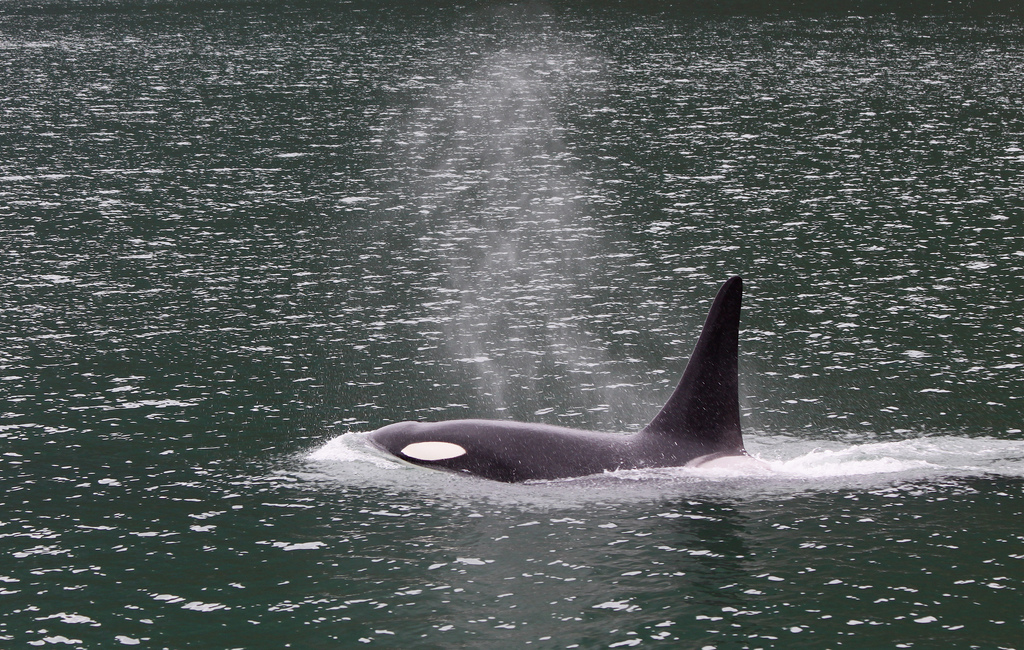Chloe Robinson from the University of Swansea is teaming up with Sea Watch for her latest study. You may have spotted Chloe representing Sea Watch on the recent Anglesey addition of Countryfile? If not, catch up with the episode here until 20th March 2018. Either way, please read on to hear all about her plans…
Yes, you read that correctly; the exhaled breath from a cetacean’s blowhole harbours a lung-full of DNA, both from the animal itself and from the bacterial flora that resides in the respiratory system. As any of you who have had a cold may know, when an infected person sneezes, lung vapour (i.e. snot) can be projected quite a distance before snot hitchhikers (i.e. viruses and bacteria) take up home in another host. A similar thing occurs in cetaceans, despite the unlikelihood of them being able to actually sneeze the same way a human does (no anthropomorphising here), when they come to the surface to breathe they exhale air at a considerable force, thus firing snot up into the air. This is more simply known as a ‘blow’, and blow height and shape varies between different species of cetaceans and a is particularly identifiable feature of large baleen whales. Smaller cetaceans, such as bottlenose dolphins and common dolphins have more subtle differences between blow characteristics, therefore dorsal fin shape is more commonly used as an ID feature.
Dorsal fins are also used as a means of identifying individuals in conservation monitoring programmes such as the Cardigan Bay Monitoring Programme run by Sea Watch Foundation. Photo ID of individuals allows estimates of population abundance and spatial distribution to be obtained and considered for long-term conservation strategies to better protect populations. In addition, information on the genetic background (i.e. family origin) of cetacean populations can generate more accurate estimations of structure and abundance. Traditionally, genetic samples are obtained by collecting a skin biopsy from a surfacing individual, however this method is rather invasive and can lead to cetaceans being shy of boats and the blubber hole left behind as the biopsy is taken can leave the individual prone to infection. In an attempt to overcome these issues, skin swabs have also been trialled, but this method is also semi-invasive which has seen smaller cetaceans shying from boats as a result of trying to collect samples.
More recently, with advancement of DNA extraction kits and techniques, blowhole sample collection has opened up an ocean of opportunity (pun intended) for successfully collecting DNA from cetaceans. Blow sampling has been used in a number of larger species since 2010, including North Atlantic Right whales, humpback whales and bowhead whales using both drones and poles equipped with Petri dishes to collect the blow spray.
Studies have also been carried out on smaller toothed cetaceans, including killer whales and beluga whales, where blow samples have been successfully collected and analysed to assess the relatedness of individuals and the variety of bacteria species which exist in the lungs. This has enabled the health of the whales to be assessed and a better understanding of the population structure to be established. However, this method has not been tested in much smaller species, primarily because it is assumed the reduced lung capacity would make it difficult to collect enough snot to analyse any DNA. The lung capacity of a large baleen whale such as the humpback is around the size of a small car (imagine a Ford KA) and in comparison, the lung volume of a bottlenose dolphin is roughly that of two rugby balls, so you can see why it has not been attempted.
Here in Wales, we hope to collect blowhole samples with the help of a number of boat operators around the coast to trial whether this could be a viable way of collecting DNA from smaller cetaceans (i.e. bottlenose, common and Risso’s dolphins). Working with Sea Watch Foundation as one of the partners, we will collect blowhole samples opportunistically during routine surveys from bottlenose dolphins to assess genetic diversity of the semi-resident populations to complement an existing photo ID catalogue of individuals. In addition, we are hoping to investigate the health status of our coastal cetaceans as a whole, by comparing the bacteria found in the lungs of a variety of species in numerous locations around the UK. We will be utilising the Petri-Pole method, dubbed the ‘Snotty 2018’, to collect samples and results of preliminary attempts look promising.
So watch this space— we hope to bring you results-a-plenty at the end of the 2018 survey season.
Chloe Robinson





























